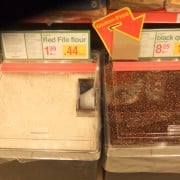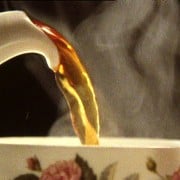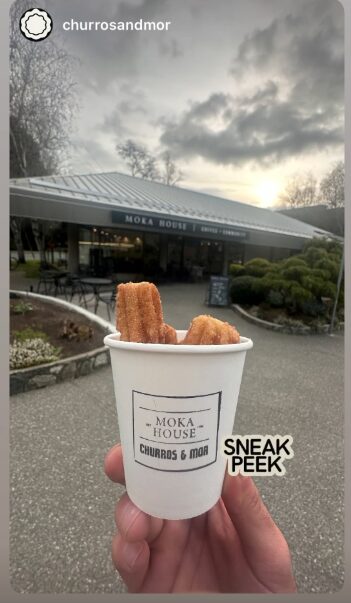Mushrooms, Strawberries, Soy and Beans can be Cross-Contaminated with Gluten
Jane Anderson‘s article, ‘Surprising Foods That Can Gluten You!’ is an eye-opener for celiacs and those dedicated to being gluten free. Inherently gluten-free mushrooms, strawberries, soy and beans through growing practices, in the field, as a result of crop rotation, during milling and manufacturing. Published in About Health.
Comments within [ … ] have been inserted by The Celiac Scene, sourced from the Celiac Listserv.
Subscribe to Celiac Listserv.
Four Fresh Foods at Risk for Gluten Cross-Contamination
“Sure, at times it is pretty simple (that restaurant salad where you found a crouton in the lettuce, for example). But when you’re mainly eating at home and eating mostly fresh products (little in the way of packaged goods), it can come as a truly unfair surprise when you get glutened anyway.
What you may not realize is that there are several fresh foods that nonetheless are subject to significant gluten cross-contamination (albeit in very small amounts). For those of us who are particularly sensitive to trace gluten [i.e. ALL celiacs] , these foods represent risks … and risks you’d most likely never suspect, either.
Mushrooms are delicious and have many health benefits. But sadly for those of us with gluten issues, they’re also frequently cultivated on straw from gluten grains — most often rye, but sometimes wheat, too.
This doesn’t leave much gluten on the mushrooms (we’re talking tiny amounts, well below the legal threshold for “gluten-free”), but it’s plenty to make some of us sick. The solution? Try to find sources of wild mushrooms at farmer’s markets and online. Learn more: If Mushrooms Are Gluten-Free, Then Why Do I Seem To React To Them?
- [A timely interview with the Quality Assurance Mepartment of Monterey Mushrooms was just published on the Celiac Listserv by Pam Newbury,
- “I have grown mushrooms (shiitake, oyster, ganoderma) in the past, and am familiar with how mushrooms are produced and how they grow. To confirm my understanding, I spoke to the Quality Assurance manager at the Royal Oaks facility for Monterey Mushrooms in Watsonville, California.
- Agaricus bisporus (button mushrooms, crimini, portabella) grow on a layer of peat moss over the composted wheat straw, the only way the mushrooms could come into contact with the wheat is by dust from other parts of the operation somehow getting into the grow room and settling on the mushrooms.
- The mushrooms form on top of 4 inches of peat moss that is layered on top of the wheat straw substrate. They do not push up through the substrate; only the mycelium comes into contact with the substrate. The mushrooms themselves never come into contact with the actual wheat straw. They are just the fruiting body (reproductive/spoor producing part) of the mushroom “plant” (mycelium) which has colonized the substrate (where the wheat straw is).
- The growing and harvesting are done in climate-controlled indoor rooms where the air in the growing rooms is filtered, so dust from the wheat straw is unlikely to come into the facility where the mushrooms grow. The three areas of the farm, composting, pasteurization, and fruiting, are all separated by distances of 1/8 mile. The mushrooms, once picked, are in closed facilities for all but about two minutes of transfer time.
- Unless the mycelium somehow manages to take gliadin protein from the wheat in the substrate and deposit it unchanged into the fruiting body (which to my understanding is not possible), I don’t see how mushrooms could contain wheat protein.
- Shiitake are always grown on wood. They won’t grow on straw. Oysters grow on straw, but I wouldn’t worry about it because of the reasons listed for agaricus; the mushrooms themselves don’t come into contact with the substrate.]
Farmers have many uses for the wheat straw left over when the grain kernels are removed, and bedding strawberries is another common use.

Strawberries can be grown on straw, too. AntiMartina/Getty Images
Straw makes a great bed for the strawberry plants, protecting the plants themselves from frost and keeping the fruit up off the ground. But it doesn’t work out that well for those of us who react to minute amounts of gluten grains. The solution? Make friends with a farmer who beds his plants on plastic, not straw.Learn more: It’s the ‘Straw’ In Strawberries That Gives Us Problems
- [C. Hufford, also on Celiac Listserv offers these comments about strawberries, I grew up next to a strawberry farm and lived around commercial strawberry production (in California) all my life. I’ve never once seen any commercial strawberry field that used actual straw to protect the berries from the earth. The amounts of straw required would be vast. I think the use of wheat straw is likely limited to smaller farms in areas where wheat straw is easy to come by. Before eliminating strawberries from your diet, check into local growing practices.]
Soy Issue Involves Shared Equipment
Many of us react to soy, which happens to be a particularly allergenic food, even without the prospect of gluten cross-contamination. But what got my attention when it came to soy is that my reaction was identical to my gluten reaction — right down to the dermatitis herpetiformis I get when I’ve been glutened even a tiny bit.
As it turns out, soy is incredibly cross-contaminated because most farmers who grow soy also grow wheat, and they use the same equipment (combines, storage and trucks) for both. The solution? Purchase soy sauce labelled gluten free. Learn more: Soybeans Among the Most Cross-Contaminated of Crops
Beans Cross-Cropped with Gluten Grains
This photo of a farmer’s fields in Washington state tells it all: the greenish-yellow fields are lentils, and the brighter green fields are wheat. Next year, they’ll swap places, with the lentils moving to the wheat fields and the wheat moving to the lentil fields.
Farmers who grow beans [and hemp TCS] almost always grow them in rotation with a gluten grain, most frequently barley or wheat. And as with soy, they use the same equipment to harvest both. I’ve found barley kernels in a bag of “naturally gluten-free” lentils, and many others have, too. The solution? Check out the article linked below for sources of beans that are tested for trace gluten. Learn more: The Safest Options for Gluten-Free Beans
- [C. Hufford shares thoughts on legumes, again from Celiac Listserv, Legumes: Now here is a real problem. Every time I have ever bought lentils I have sorted through them and always find stray wheat grains among the lentils. I think it’s the similar size that makes it hard to sort out the lentils from wheat. I always sort carefully and rinse well. I’d be careful of commercially processed lentil products for that reason. I would expect some cross contamination there.]
Jane Anderson concludes, “Please Note: Not everyone will react to these foods in fact, the majority of people with gluten issues probably will not, simply because they’re not that sensitive. But some of us will, so I’m hoping this list can help you track down where your symptoms may originate (not to mention, provide you with some solutions to keep enjoying foods you love!).”
The Celiac Scene thanks Jane Anderson for this article and for her work to create awareness about celiac disease and the gluten-free diet.
The Celiac Scene asks, “Do you have observations about gluten creeping into your life?
Here’s mine: When your pharmacist counts and dispenses your gluten-free medication, does he/she use a clean tray and equipment?
Remember, there are no wrong theories, just conspiracies to suppress them!













